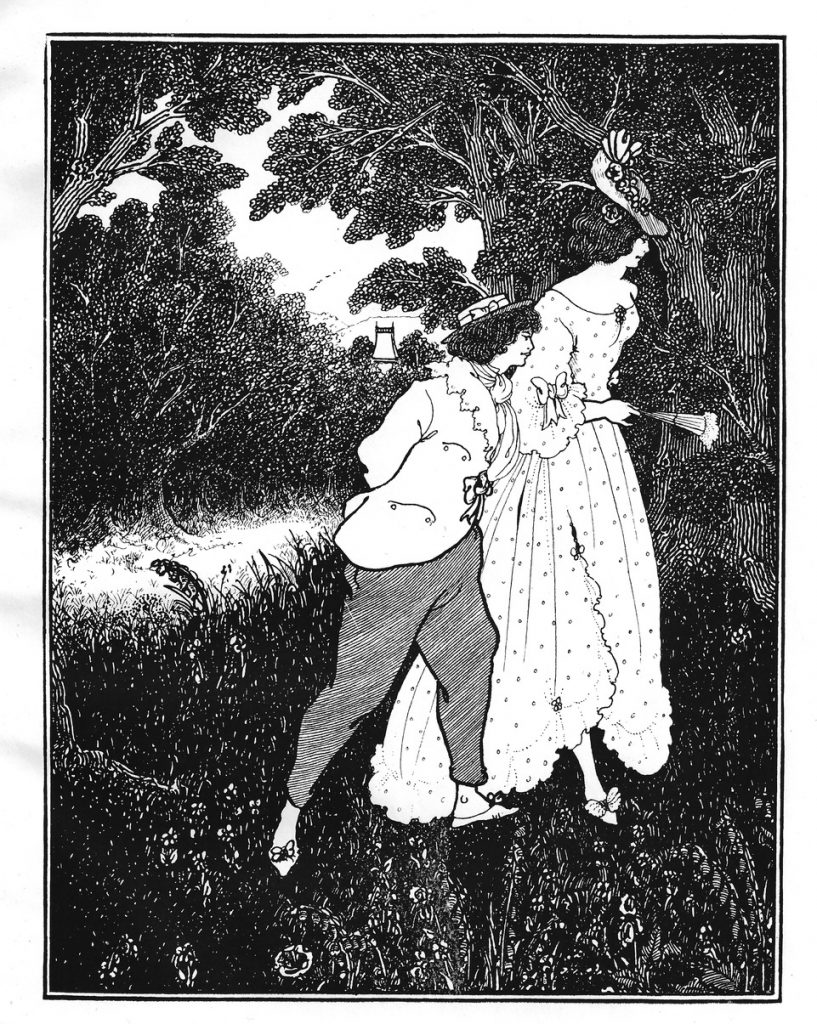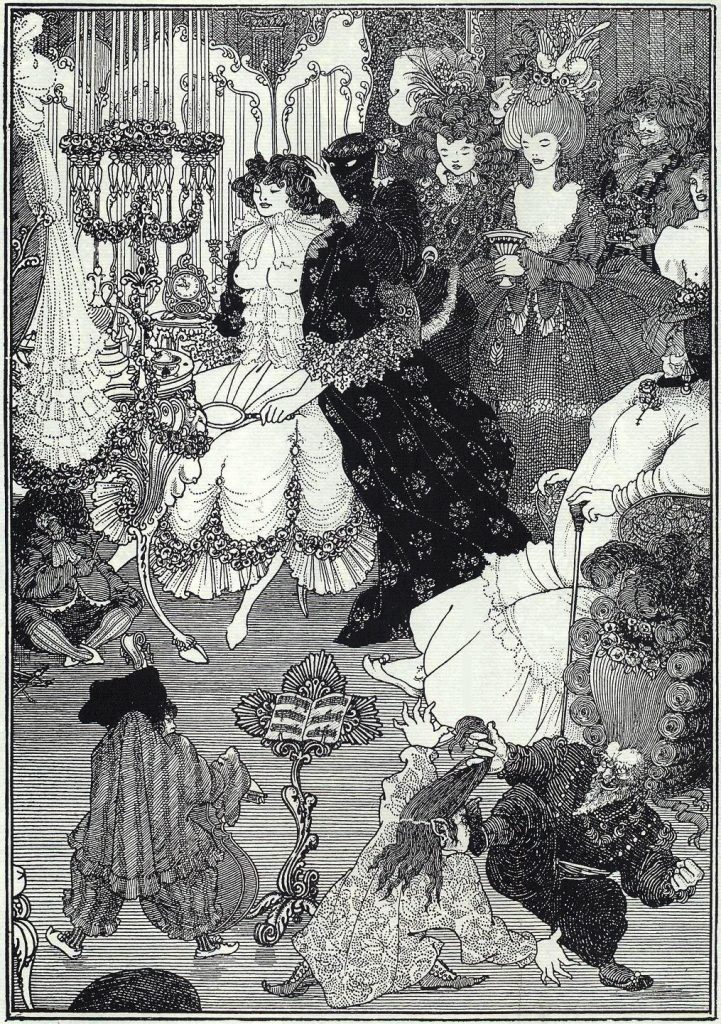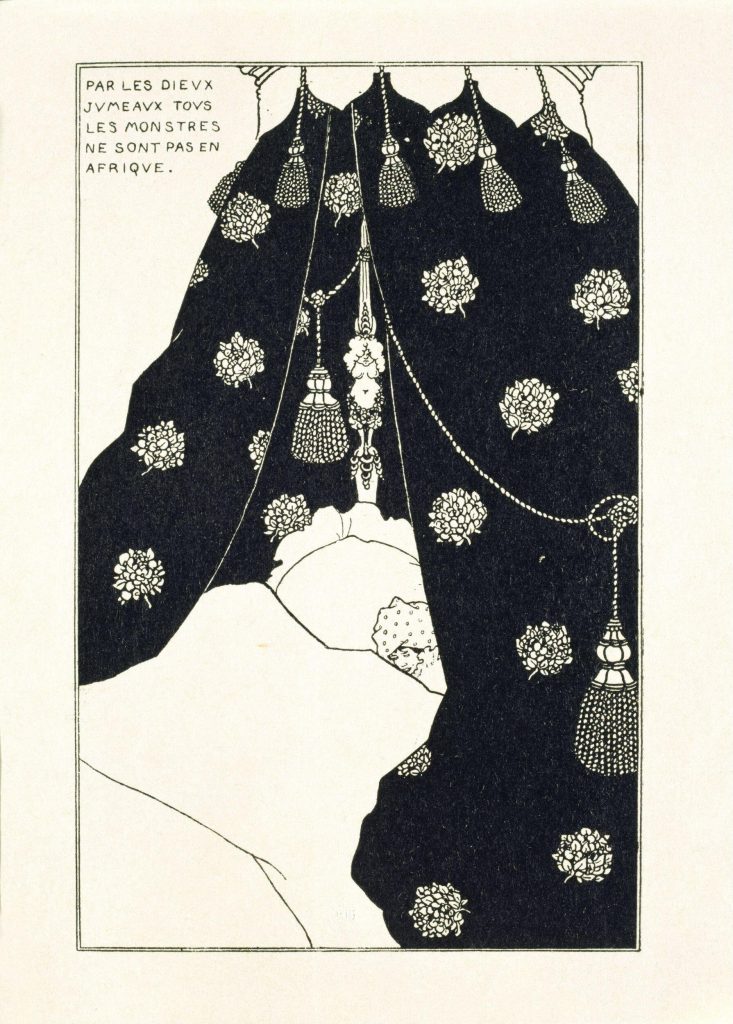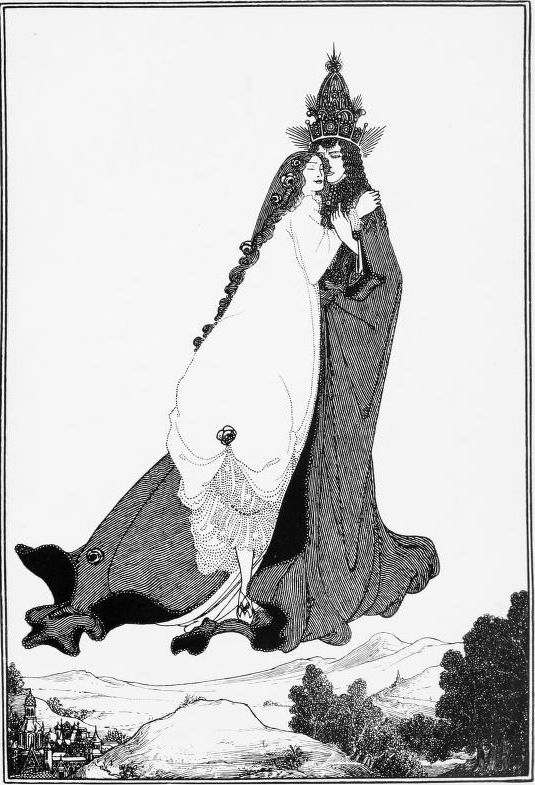This paper by Annette Lavers, a pioneering scholar of Beardsley’s literary output, is published here for the first time from the author’s typescript which she shared with Simon Wilson in 1998. Lavers is a former Fielden Professor of French Language and Literature at the University College London. It should be noted that although at this time Lavers had briefly examined the original manuscript of Under the Hill, for this paper she was referring to the 1907 Smithers edition, with its different chapter divisions. Read Part I here.
Every effort has been made to trace copyright holders and to obtain their permission for the use of this material. Please do get in touch with any information relating to this text or the rights holder.
L’Eau Savante: Aspects of Erotic Writing in Aubrey Beardsley
Part II
One becomes aware of a dual intention: to shock the bourgeois through intrepid mentions of panoramic sex, but also to educate him emotionally. The narrating voice constantly apostrophizes him through abrupt changes of register (‘I can tell you’), turning him into a voyeur, now shocked like the English tourist who witnesses an idyllic coupling in the poem ‘The Three Musicians’ and ‘sends up a prayer for France’, now prurient when he is made to ask for details about the fate of the petits chevaux or is left to guess as some ‘curious pranks’ of Venus’s retainers. This voice occasionally confides in us: ‘Yes, he was a bawdy creature’, and comments wryly: ‘These were the delights of this young man’s life’ after describing a case of love being ‘shameful and ridiculous’, since a practice which would seem repulsive to most of the tolerant denizens of the Venusberg, let alone most of Beardsley’s readers, causes apprehensive jealousy in this character lest the newcomer Tannhäuser usurp his place.

This relationship between narrator and reader animates the tale and compensates for what static artificiality might result from a mere sequence of hedonistic pursuits, suited as these are to the timelessness of the Venusberg. These occupations are described in a way which shows profound nostalgia for the humane and civilised values of the Enlightenment, from Régence to rococo, those of Voltaire’s militant poem Le Mondain (date?) with its belief in progress, industry, and happiness, its gaiety, wit and tolerance, its faith in pleasure and refinement. Grace is seen as intelligence, as in the ‘fine relevant art of coiffing’, which Beardsley takes for a symbol of his own art.[1] Loveliness endlessly fascinates because it ‘can never be fully understood or enjoyed to the utmost’, like an individual melody. Elegance is a guarantee of control, but invention reigns supreme against a backcloth of shared values in a social life conceived as permanent spectacle.
The word ‘curious’, which expresses this ultimate value, recurs with a frequency which legitimizes its usage in curiosa, uniting as this does admiration for cultural ingenuity and curiosity about natural behaviour. The catalogue of sexual practices is, one feels, meant to be complete: narcissism and voyeurism in Tannhäuser, fetishism in Venus’s courtiers, onanism, masturbation, same-sex scenes active and passive, as well as transvestism, irrumation, cunnilingus, fellatio, coprophilia and bestiality, and even virginity and celibacy as sexual variants, are presented in ingeniously allusive terms, as well as the ‘doubtful creatures’ surrounding Venus, whose presence equates sports of nature with unheard of orientations. To underline his message, Beardsley adds some comical and imaginary sexual fixations (on ear wax or spit) which sketch Venus, the universal object of desire, as very corporeal but without any of the disgust found in Church fathers’ diatribes about femininity.[2] Her body, the fulcrum of this world, in her boudoir where screens redouble the intimacy of her shape and of her sex, suggests infinite combinatorial metamorphoses, the plasticity of eros, the seductive life-force which can metaphorise the entire world, as the surrealists also realised.[3]

Venus as universal whore is a theme found from classical times to Offenbach and lending itself to heroi-comic treatment. But this radiant meretrix is saved by the child-like amorality at the heart of her relationship with a tamed Priapus.[4] Thus the romantic and fraught encounter in Wagner yields here to the grotesque shock of having, immediately after a poetic sexual scene between the heroes, Priapusa and other courtiers ‘burst drunkenly into the room and claim Venus for themselves’. The logic of the orgy, with orgasmic culminations, is in fact the controlling device of the narration, practically all chapters ending in such shocks after an idyllic beginning. The Dionysian representation of uncontrolled desires, with all its farcical potential, is the indispensable counterpart of the Apollonian control of elegance and self-knowledge. This helps the reader to discover the disquieting nature of the Venusberg – a familiar device in many similar textual or filmic narratives. This reader becomes as suspicious as Beardsley’s unfortunate publishers, scanning his designs for the inevitable unprintable details.
In fact, however, this sexual catalogue is selective: the major Decadent theme of sado-masochism, with its motifs of murder and necrophilia, found in Beardsley’s graphic work or poems such as ‘The Ballad of a Barber’, is (practically) missing in Venus and Tannhäuser. Even the bacchanal has a thoroughly pleasurable and educational content: the dandies engineer a reversal of roles, but their surrender serves their sensuous purpose: for ‘who is not pleased when in the fountain’s wave Love holds its court, and the insistent water burrows in every delicious crease and crevice?’ They had come to infuse their ‘venom’ into innocent shepherds and satyrs, but there is no suggestion of the all too literal wound through which Baudelaire dreams of infusing his venom into his mistress.[5] This is because sadism is now seen as resulting from frustration, and Venus’s empire is meant to be the land of heart’s desire. Beardsley has in fact invented a genre, the erotic pastoral.
And yet the narrative voice, which normally keeps testing ‘how far to go too far’ (in Cocteau’s phrase) occasionally undermines its own values and becomes judgmental: we hear about ‘terrible voices and worse gestures’, a ‘voice full of salacious unction’, ‘the corrupt characters of Dorat’, ‘the décolleté spirit of astonishing conversation and atrocious laughter’. So this arcadian landscape is not without shadows after all – ethical and existential.
The puerility of hero and heroine seems at first to confer the innocence of the polymorphous perverse. This is a feature of the Decadent period, and not devoid of virtue, since its scepticism could usefully deflate the pompous hypocrisy of Victorian worthies. But it has here a slightly sinister paedophiliac aspect, either in Tannhäuser’s own tastes or in some comments of the narrator about Sporion’s seduction of children.[6] One could argue this is a last citadel of convention which has to be stormed, if one did not remember Wilde’s description of Smithers’ tastes and the existence of contemporary brothels. This controversy is also at the heart of Freud’s theory, since his discovery of fantasy signals a retreat from his earlier view of bourgeois fathers as seducing their daughters. Glossing over this provocative aspect involves in Freud a stress on children’s sexuality, and sure enough the scene which arouses Tannhäuser most shows a solipsistic expression of a girl child’s desire.[7]

This aspect is not merely exploitative, however, since the strength of his hero’s reaction points to the identifications of an author whose anxieties are clearly linked to the underlying theme, namely his doubts about an enduring possession of adult status. Even in the sunny poem ‘The Three Musicians’, the drawings show a child lover with a fully-grown woman. Beardsley’s earlier obsession with the foetus motif is also in part a metaphor for the stillborn self, and in Portrait of Himself, the little smiling child lost in a big parents’ bed is in the accompanying text cheerfully called a monster. There are grotesques, in Venus and Tannhäuser, but not many adults, not even the viragos or the brutal but virile monsters we find in Beardsley’s drawings: Messalina, Valmont, the Impatient Adulterer or Herodias: it is with the youthful Salome and her displaced longings that Beardsley had first identified. We do find one adult, in his tale, the painter (in oils) significantly called De la Pine (slang for penis). One thinks of an amusing comment in Praz on the cliched childishness in parodic versions of myths written or painted by Decadents such as Laforgue, Swinburne or Moreau, so different from robust Romantic representations: ‘We have travelled far from Delacroix’s Sardanapalus, who contemplates with a satisfied air the hecatomb of lovely slave girls. Could this De La Pine hint at an unreachable fulfilment symbolised by the earlier age of Delacroix – as well as provide a neatly blasphemous opposition between the cross and the phallus?
The unicorn Adolphe is the only character under the hill who daily feels the fear of rejection. His ‘monstrous’ animal size prevents a direct connection with his divine mistress, yet it is only the flowing ‘melody’ of his morning pleasure after her visit which can restart life in the Venusberg. The key to this autobiographical figure and to the author’s ambivalence about its meaning is found in Tannhäuser’s reverie in Chapter VII, which is in fact a string of free associations: first he thinks of the Roman de la Rose, an obvious reminiscence of his recent sexual encounter with Venus, then of an ideal world in Claude’s paintings and of an ideal escape from sex in the hagiographic episode of St Rose de Lima, of the opening of Racine’s Britannicus, where Agrippina is beginning to fear her son Nero, the ‘nascent monster’ who has for the first time imposed his desire above all laws, of the recent bacchanal, of ‘love’, and of a pamphlet in Venus’s library, entitled ‘a plea for the domestication of the unicorn’ – whose anxieties are depicted in the following chapter. This wish for liberation from the tyranny of sexual longings reminds us of a more explicit and punning self-portrait called A Footnote, where Beardsley pictures himself as an invalid painter fatefully tied to a bust of the pagan god Pan. Yet Adolphe sings, the Venusberg wakes up, and the author went on using his brush until the end.[8]

We often read that Beardsley is artificial, hovering culpably over common humanity, and at the same time, somewhat astonishingly in this day and age, that he is dirty-minded, and as such infra-human. But just as dirt is matter in the wrong place, we call dirty-minded someone who arouses us at the wrong time. Some would have it that Beardsley is doing just that. One would not argue with any interpretation, however damning, which reflects an authentic experience of his genius. Presumably some people see in his work an intimation of evil, either in themselves or as an ambient threat. Yet this evil atmosphere is not, to say the least, what we find in his boyish celebrations of his power to create a world and to render it in ways never seen before. For all the provocation it contains, we find in Venus and Tannhäuser an amused detachment, a kind of maturity which we could do worse than adopt as a philosophy. In a witty rejoinder to those who had criticised his title page for the first volume of the Yellow Book, which shows a lady playing the piano in a field, Beardsley quoted the contemporary description of the way Gluck used to compose his operas in precisely that posture, on a piano he had installed in a meadow, and keeping at hand bottles of champagne. And he adds that he trembles to think what critics would have said if he had put in his drawing those decadent bottles as well. It is this attitude, maintained by Beardsley in the teeth of so much provocation from puritans and from life itself, that we should adopt about him: admire the truth in his work, admire his insouciance in ignoring it when he chooses, and above all enjoy the champagne.
Notes by Annette Lavers
[1] The coiffeur Cosme who produces ‘delicious, intelligent curls’ thus resembles the hero of ‘The Ballad of a Barber’ who ‘could with ease /Curl wit into the dullest face’. The autobiographical resonance of the latter’s description (‘His daily task was all he loved, /And now and then a little praise’) finds literal confirmation in Beardsley’s correspondence: to Mabel, ‘Really nothing but work amuses me at all’ (by November 1896), and his concern for his ‘monument’, Fifty Drawings; see The Letters of Aubrey Beardsley, p. 386.
[2] This is the time when it begins to be felt that sexual practices have to be catalogued and have (scientific) names, a restrictive and potentially punitive ‘medicalisation’ eschewed by Beardsley’s literary practice. His attitude puts him on the side of a D.H. Lawrence, against authors like Swift or Church Fathers cited in, say, Sartre’s Le Diable et le Bon Dieu. [The Devil and the Good Lord] 1895, the year of Venus and Tannhäuser, is also that of Freud’s Interpretation of Dreams, and the idea of a norm, which organises most practices as ‘deviations’ or even ‘perversions’ from it, has caused much resentment against psychoanalysis.
[3] The description of Venus’s body is in some ways reminiscent of the famous doll by another outstanding draughtsman, Hans Bellmer, who was an admirer of Beardsley’s story (personal communication). As for her general looks, the author states that she ‘looked like K-‘. Could this ‘K’ be Kitty Savile-Clark, who with her sister Maggie, was at Dieppe at the same time as Aubrey and Mabel? For these two ‘professional beauties’, who are probably the ‘bathers’ of Beardsley’s drawing, and for a description of Kitty, see Jacques-Émile Blanche, La Pêche aux souvenirs, [Fishing for Memories] sections ‘Dieppe, l’année de Beardsley’ and ‘les Ondines’ – Blanche painted Aubrey, Mabel and Kitty, and gives a description of the Dieppe casino’s ‘petits chevaux’.
[4] Some critics have commented on the resemblance of the highly symbolic Priapusa with Wilde, in Beardsley’s illustration. If this is so, it shows how for him the fateful figure of Wilde, for better or worse, dominated the ethical and esthetic [aesthetic?] ambitions and achievements of the age – an opinion which seems to be supported by the testimony of Franz Blei, who met Beardsley at the Hotel Voltaire in April 1897 and wrote a sequel to Venus and Tannhäuser.
[5] ‘A celle qui est trop gaie’, in Les Fleurs du Mal: ‘Je voudrais […] faire à ton flanc étonné / Une blessure large et creuse, /Et […] à travers ces lèvres nouvelles…/ T’infuser mon venin, ma soeur!’. [‘To she who is too lighthearted’ […] ‘I would like […] to make in your astonished side/ A wound both wide and deep, /And […] through these newly made lips […] / Infuse my venom, my sister!]. The Marquis de Sade is yet another author found on Salome’s well-stocked bookshelves.
[6] Sporion’s name may come from Spores, the young Roman whom Nero ‘married’, as recounted by Suetonius, who also describes Tiberius’s games with children in his bath, similar to Tannhäuser’s. Incidentally, Bathyllus, the object of two drawings illustrating Juvenal’s Sixth Satire, already had emblematic status since Verlaine’s famous sonnet ‘Langueur’, whose first line ‘Je suis l’Empire à la fin de la dècadence’, [I am the Empire at the end of the decadence] gave the ‘Decadents’ their name.
[7] Her posture (in Chapter IX) is not unlike that of ‘Woman’ in the drawing Juvenal Scourging a Woman which adds rather different connotations to the interpretation of this work. On her name, Rosalie, see note 17.
[8] In order to fit in these associations, Beardsley changed the time when Tannhäuser wakes up in the manuscript, 11 a.m., to 8 a.m. in The Savoy version – unlikely perhaps after a sexual encounter with Venus, but showing the author’s meticulous attention to his story! The theme of the Rose, through the medieval Roman de la Rose, gives Venus and Tannhäuser its epigraph – ‘La chaleur du brandon Venus’. It is a traditional metaphor for the female genitalia, and, as we saw, the structure of Venus’s boudoir, and is not only found graphically throughout Beardsley’s work (where there are as many roses as phalluses – see, for example, Salome, The Mysterious Rose-Garden, etc.), but again in the name of the emblematic child Rosalie, and that of St Rose of Lima. The evocation of the latter can hardly be called ‘camp’, as one sometimes reads, when we remember the invocation to the Virgin by Wagner’s Tannhäuser, who seeks her help to escape Venus; the drawing that dramatises the drift of these free associations, and the content of the drawing A Footnote.